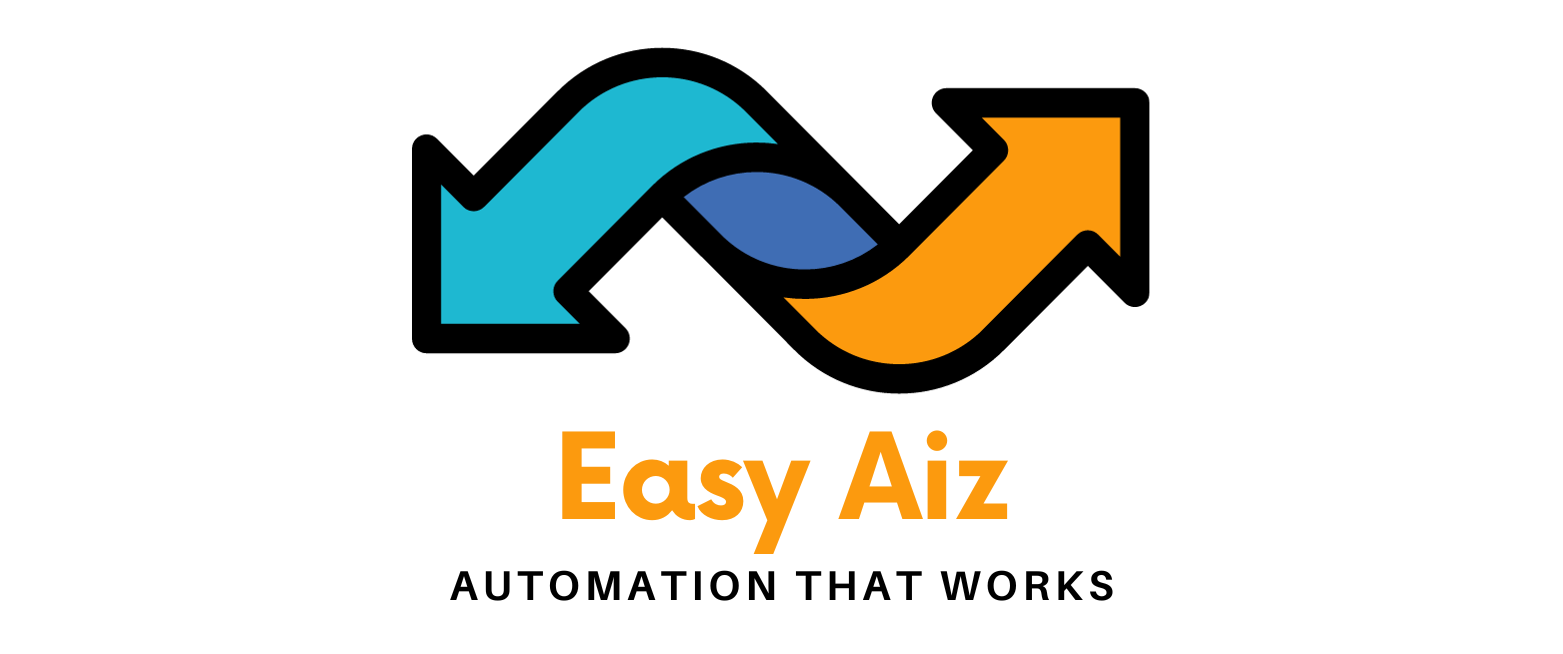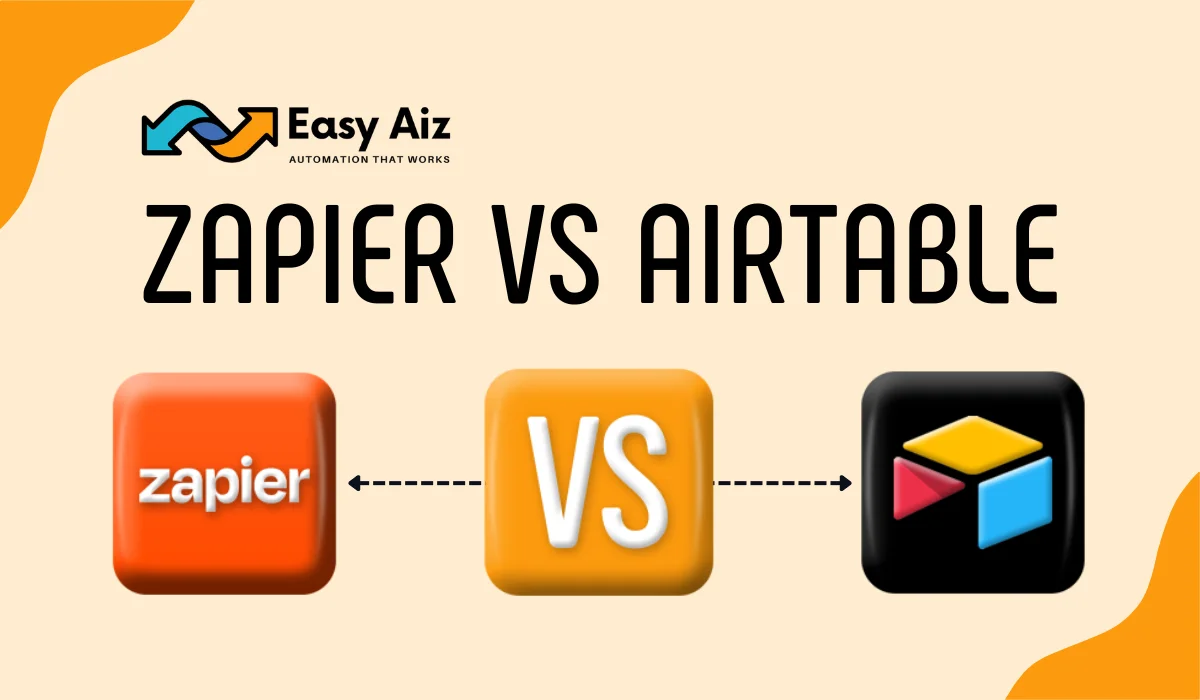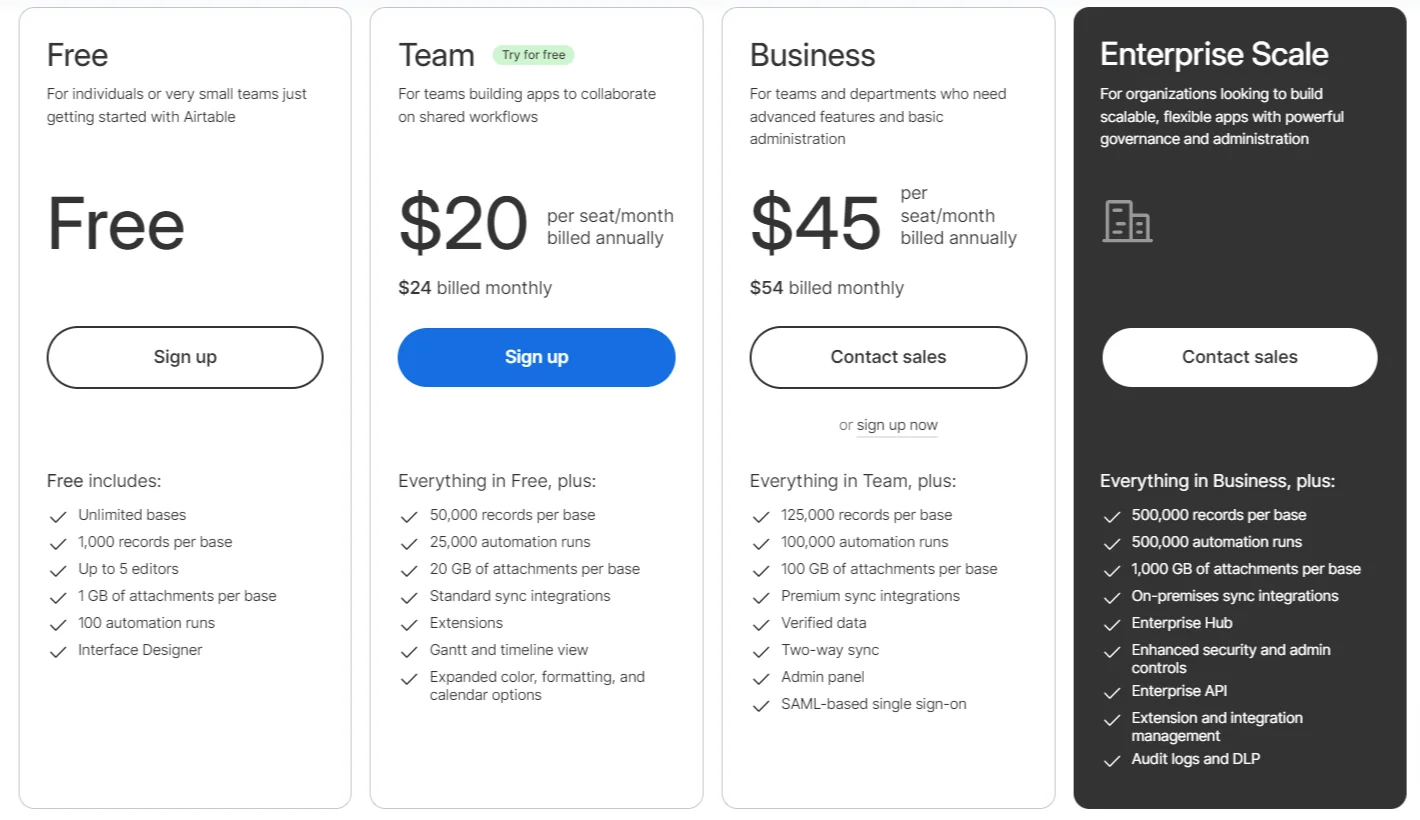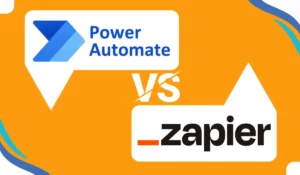Table of Contents
ToggleZapier vs Airtable
Key Takeaways
- Assess your workflow requirements and choose the tool that best aligns with your objectives, whether automation with Zapier or database management with Airtable.
- Take advantage of Zapier’s extensive app integrations and Airtable’s API to connect your favorite tools and streamline processes.
- If collaboration is necessary for your projects, Airtable’s real-time collaboration features make it a strong contender.
- Compare the pricing plans and features offered by Zapier and Airtable to determine the best value for your budget and requirements.
- Keep up with updates and new features from Zapier and Airtable to maximize the benefits of these platforms for your workflows.
Everyone is constantly searching for tools to streamline their processes and boost the productivity of their business. Two popular names in this search history are Zapier and Airtable. While both platforms offer workflow automation and data organization solutions, they have different purposes based on different needs. It is necessary to learn the differences between Zapier and Airtable can help you decide which tool is best suited for your business. Let’s start with the basics!
What is Zapier?
Zapier is a simple and powerful automation tool. Its main task is to connect your apps and services with 7000+ applications. It works on the principles called “Zaps”, which starts with a trigger event and ends after completing the given actions. With Zapier, you can create Zaps that integrate various apps, such as Gmail, Slack, Google Sheets, and more to streamline workflows by performing your repeated tasks.
Zapier Pros
-
Seamless automation of repetitive tasks.
-
App integrations with over 7,000 supported apps.
-
Customizable workflows to create automation for specific needs.
-
Multi-step Zaps for complex automation.
-
Notification alerts to stay informed about workflow events.
Zapier Cons
-
Limited functionality beyond automation.
-
Higher pricing for advanced features and integrations.
-
Dependency on third-party app integrations.
-
The learning curve for setting up complex Zaps.
-
Task limits on free and lower-tier plans.
What is Airtable?
Airtable is a flexible and collaborative cloud-based database platform that combines a spreadsheet’s functionality with a database’s power. It is similar to Coda and Notion, you can easily create customizable databases, known as “bases”, to store, organize and manage information in an attractive and user-friendly interface. In Airtable you can include customizable fields, views, and powerful filtering options, and you can easily use it for various purposes, from project management to CRM (Customer Relationship Management).
Airtable Pros
-
User-friendly database management with a visually appealing interface.
-
Customizable fields and views for organizing and analyzing data.
-
Real-time collaboration with multiple users on the same base.
-
Built-in integrations with popular tools and API for custom integrations.
-
Free plan with unlimited bases and generous record limits.
Airtable Cons
-
Limited automation capabilities compared to Zapier.
-
It is more challenging to learn to set up complex databases.
-
Dependency on internet connectivity for cloud-based access.
-
Lack of advanced data analysis features compared to dedicated analytics tools.

Features and Use Cases
Zapier:
-
- Automation: Zapier helps automate repetitive tasks by creating Zaps that connect different apps and services.
-
- Integration: Zapier connects you over 7,000 apps like Slack, Trello, Salesforce, and more. It is an excellent apportunity to achieve easiness and productivity.
-
- Workflow Customization: You can trigger the Zaps and perform the actions you require based on some conditions and change the Zaps whenever your requirement change.
-
- Multi-step Zaps: Zapier supports multi-step Zaps. It is a straightforward support to create complex automations with multiple apps and actions.
-
- Notification Alerts: You can set up notifications to notify you about specific events or triggers within their workflows.
- Core Features: Zapier Canvas, Interfaces, Custom Chatbots, and Zapier Central automatically increase productivity automatically.
- Create numerous Zaps: You can create as many Zaps as you like until your tasks ends.
Airtable:
-
- Database Management: Airtable provides a user-friendly interface for creating and managing databases. It is simple to organize and store information efficiently.
-
- Customizable Fields: You can create custom fields to capture various data types, including text, numbers, dates, and attachments.
-
- Views and Filtering: Airtable offers multiple views, such as grid, calendar, and gallery, as well as powerful filtering options to visualize and analyze data in different ways.
-
- Collaboration: Airtable supports real-time collaboration that helps multiple users to work on the same base and track changes with revision history simultaneously.
-
- Integration: While Airtable has built-in integrations with popular tools like Slack, Google Calendar, and Dropbox, it also offers an API for custom integrations with other applications like Zapier.
How to use Zapier?
Create a Zap to connect your apps and services. Choose the Trigger App that you want to trigger an action in. Choose the specific trigger event, connect your trigger app account to Zapier, and follow the instructions to grant Zapier access. Set up an action app, and then choose the specific action event you want to perform in the selected app.
Now it’s time to Connect the Account and Customize the Action. Connect your Action app account to Zapier and customize the Action by mapping the fields from the trigger app to the corresponding fields in the Action app. Once you’ve set up your Zap, test it to make sure it works as expected. Finally, turn on your Zap to start automating tasks between your apps.
How to use Airtable?
Create a Base in Airtable and choose a template, or start from scratch. Set Up Tables and Fields in your base, and create tables to organize your data. Each table can have different fields to capture different types of information (e.g., text, number, date). Enter data into your tables manually or import data from CSV files or other sources. Customize your views to interact with your data by creating different views, such as grid view, calendar view, or gallery view. Share your base with team members to collaborate in real time. You can set permissions to control who can view or edit the data.
Use integrations like Zapier to automate tasks and streamline workflows by connecting Airtable with other apps and services. Explore advanced features like formulas, filters, and linked records to customize and analyze your data further. Sync your Airtable base with other apps and services to keep your data up-to-date across platforms. Regularly review and update your base to confirm it remains organized and serves its purpose effectively.
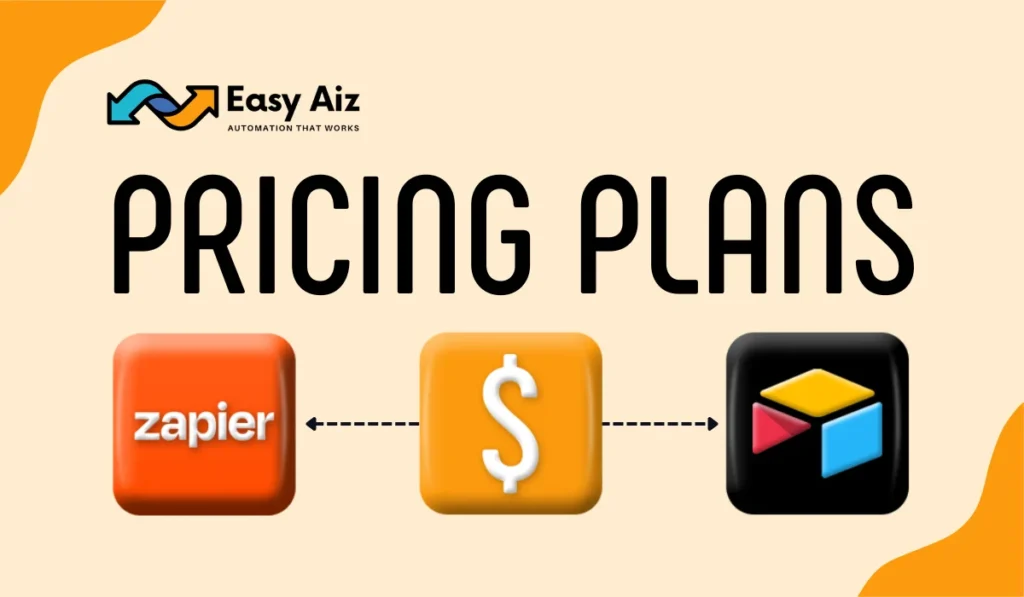
Zapier and Airtable Pricings
Zapier:
-
- Free Plan: Zapier offers a free plan with limited feature that is unlimited Zaps (automation) and 100 monthly tasks.
-
- Paid Plans: Paid plans start at $19.99 per month for individuals, $49 per month for building and managing custom workflows, and $69 per month for the teams and a custom plan for companies, offering increased automation limits and additional features such as multi-step Zaps and premium app integrations.
- Paid Plans: Paid plans start at $19.99 per month for individuals, $49 per month for building and managing custom workflows, and $69 per month for the teams and a custom plan for companies, offering increased automation limits and additional features such as multi-step Zaps and premium app integrations.
Airtable:
-
- Free Plan: Airtable offers a free plan with basic features, including unlimited bases (databases) and up to 1,000 records per base.
-
- Paid Plans: The paid plans start at $20 per user per month (billed annually) for teams and $24 only monthly, including increased record limits, advanced features like custom branding, and priority support. Higher-tier plans like Business start at $45 (billed annually) and $54 only monthly, and custom plans for businesses (Enterprise scale ) offer additional features and customization options.
- Paid Plans: The paid plans start at $20 per user per month (billed annually) for teams and $24 only monthly, including increased record limits, advanced features like custom branding, and priority support. Higher-tier plans like Business start at $45 (billed annually) and $54 only monthly, and custom plans for businesses (Enterprise scale ) offer additional features and customization options.
When to use Zapier and Airtable?
When deciding between Zapier and Airtable, consider the nature of your workflows and the specific requirements of your projects. If your primary need is to automate tasks and integrate different apps to simplify your workflows then zapier is the best choice. You will find many alternatives and competitors of it like Make, pabbly connect, integromat and more but Zapier has proven its users to come back based on its flexibility, user-friendly interface and vast library of applications and adapt to any environment you need for your business.
On the other hand, if you still use GoogleSheet as your database solution then stop using it because Airtable is your ideal fit, it will completely replace the need of using GoogleSheet, Typeform, Jotform and or any other Form type app. Stop using Airtable as your CRM or project management tool because it is on the end a database tool.
Ultimately, both Zapier and Airtable are powerful tools that can adapt to various contexts to enhance productivity and streamline processes. By understanding their differences and capabilities, you can easily select the tool that best fits your workflow needs and business goals.
Easy Aiz - Automation That Works
See how EasyAiz Automates your Business!
Get Quality Services for growing your business, 700+ companies have worked with us and saved thousands of hours and your company could be the next.
Schedule a Free Consultation planning with Certified Zapier Experts that suits your business.
Book A Free CallConclusion
In conclusion, both Zapier and Airtable offer solutions for simplifying workflows and organizing data, but they have different purposes based on different user needs. Zapier excels in automation, allowing users to connect various apps and services to automate repetitive tasks. On the other hand, Airtable provides a flexible and collaborative database platform with customizable fields, views, and powerful filtering options.
FAQs
No, Zapier and Airtable serve different purposes and are not direct substitutes for each other. Zapier focuses on automating workflows and integrating apps, while Airtable is designed for database management and collaboration.
Zapier can automate tasks and integrate Airtable with other apps and services. For example, you can create Zaps to automatically add new Airtable records from form submissions or trigger actions in different apps based on changes in Airtable.
Yes, both Zapier and Airtable offer plans based on the needs of small businesses, with affordable pricing options and scalable features.
Yes, Zapier and Airtable offer flexible subscription options, allowing you to cancel or downgrade your plan anytime.
Both platforms provide customer support through different channels, including email, help center documentation, and community forums.
